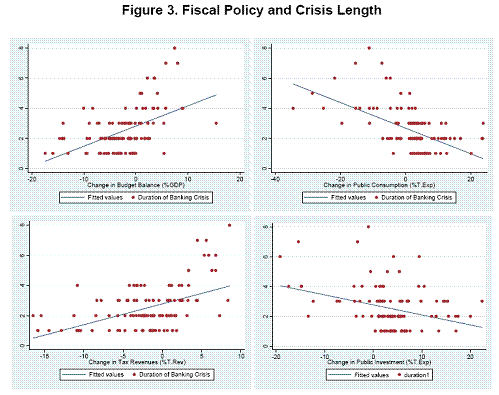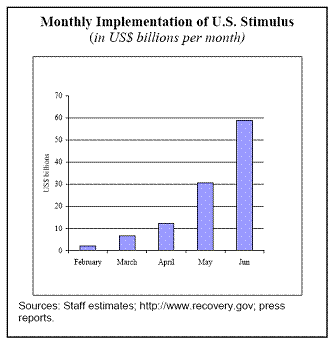From the conclusion to “How Effective is Fiscal Policy Response in Systemic Banking Crises?”, by E. Baldacci, S. Gupta, and C. Mulas-Granados:
This paper assessed the effects of fiscal policy responses during 118 episodes of systemic
banking crises in advanced and emerging market economies. The results indicate that timely
countercyclical fiscal responses (both due to discretionary measures and automatic
stabilizers), accompanied by actions to deal with financial sector weaknesses, contribute to
shortening the length of crisis episodes. During crisis caused by financial sector distress,
fiscal expansions increase the likelihood of earlier exit from a shock episode. Expansionary
fiscal policies reduced the crisis duration by almost one year. These results hold for different
definitions of crisis duration and alternative specification and estimation methods. The
findings are consistent with recent studies that highlight the importance of countercyclical
policy in response to recessions associated with financial sector problems (Classens, Kose,
and Terrones, 2008; IMF, 2009b; IMF, 2009c).
Initial fiscal conditions matter for fiscal performance during shocks. In countries with high
precrisis ratios of public sector debt to GDP, lack of fiscal space not only constraints the
government’s ability to implement countercyclical policies, but also undermines the
effectiveness of fiscal stimulus and the quality of fiscal performance. In countries with high
debt, crises lasted almost one year longer. The effect of high public debt on duration
completely offset the benefits of expansionary fiscal policies in these countries. Similar
results are found for countries with lower per capita income, as poor implementation capacity
and high macroeconomic risks limit the scope and the effects of fiscal expansions during
crises (Botman and Kumar, 2006). These findings point to the importance of creating fiscal
space and enhancing macroeconomic stability in tranquil times to limit the risk of falling into
crises and to enhance the effectiveness of policy responses when exogenous shocks hit
countries (Tavares and Valkanov, 2001). In emerging market economies, attention needs to
be paid to strengthening fiscal institutions, reduce political risks and improve budget
execution capacity to reap the benefits of countercyclical fiscal policies (Baldacci, Gupta,
and Mati, 2008).
The composition of fiscal expansions matters for crisis length — a point that has not been
studied in the literature. Stimulus packages that rely mostly on measures to support
government consumption are more effective in shortening the crisis duration than those based
on public investment. A 10 percentage point increase in the share of public consumption in
the budget reduces the crisis length by three to four months. Reducing the share of income
taxes is less effective than consumption taxes in shortening the length of a banking crisis.
These results suggest that tailoring the composition of fiscal response packages is important
for enhancing the effectiveness of countercyclical fiscal measures in both advanced and
emerging market economies (Spilimbergo et al., 2008; IMF, 2009).
Fiscal expansions do not have a significant impact on output recovery after the crisis though.
Crises can have long-term negative effects, damaging human and physical capital with
negative implications for productivity and potential output growth. Early recovery from a
crisis is therefore important, to minimize output losses in the short term and enhance
medium-term growth prospects. This calls for timely fiscal responses during downturns.
However, fiscal policy responses may not be effective when initial fiscal conditions are poor
and fiscal space is limited. High public debt levels and past macroeconomic instability limit
the scope for countercyclical deficit expansions and hamper the effectiveness of fiscal
stimulus measures as markets perceive the higher future fiscal risks entailed by larger deficits
(Balduzzi, Corsetti, and Foresi, 1997; Uribe, 2006).
Correlations are shown in Figure 3 from the paper:

Figure 3: from “How Effective is Fiscal Policy Response in Systemic Banking Crises?”, by E. Baldacci, S. Gupta, and C. Mulas-Granados.
This study provides some empirical basis for the argument that fiscal stimulus assists in repairing the financial system. I think it also provides a nice counterpoint to those who obsess on only the real side aspects of the stimulus package (although there are always some who believe that the financial sector is merely a veil and hence irrelevant).
Update: 7/30 6:30 pm Pacific The IMF has released a new document containing this graph, useful for those who like to refer to actual numbers. From M. Horton, M. Kumar, P. Mauro, “The State of Public Finances: A Cross-Country Fiscal Monitor,” Staff Position Note 09/21, released today:

What this indicates is that there was very little stimulus occurring, until June. Then stimulus expenditures (tax provisions and spending and transfers) were estimated to have hit (cumulative) about $60 billion. While this amount is still small relative to 2009Q1 SAAR GDP = $14 trillion, it’s not inconsequential compared to the $900 billion output gap (SAAR) [calculated by multipling the CBO output gap by the GDP deflator].
Technorati Tags: financial rescue, recession,
fiscal stimulus, ARRA.
Budget Deficits, National Saving, and Interest Rates
William G. Gale and Peter R. Orszag
September 2004
This paper provides new evidence that sustained budget deficits reduce national
saving and raise interest rates by economically and statistically significant quantities.
Using a series of econometric specifications that nest Ricardian and non-Ricardian
models, we obtain evidence of strong non-Ricardian behavior in aggregate consumption.
Consistent with several recent studies, we find that projected future deficits affect longterm
interest rates, but current deficits do not. Our estimates suggest that each percent-of-
GDP in current deficits reduces national saving by 0.5 to 0.8 percent of GDP. Each
percent-of-GDP in projected future unified deficits raises forward long-term interest rates
by 25 to 35 basis points, and each percent-of-GDP in projected future primary deficits
raises interest rates by 40 to 70 basis points.
National Bureau
of EconOmic Research
BULLETIN 58
NOVEMBER 15, 1935
4 NON-PROFIT MEMBERSHIP CORPORATION FOR IMPARTIAL STUDIES IN ECONOMIC AND SOCiAL SC!E.NCE
BROADWAY, NEW YORK
Production in Depression and Recovery
Copyrigbi 1935. National Bureau of Economic Research, Inc. A. BLISS
In 1934 recovery in the physical volume of world pro
duction continued. Although basic ‘commodities ‘did not
increase in output, those used as industrial raw ‘materials
did advance some 6 per cent, reaching a level 16 per cent
above the output of 1932. Partially offsetting this increase,
there was a decline of 2 per cent in the world’s output,
crude foodstuffs. Greater recovery has occurred in
purely industrial activity (mining, manufacturing and, in
most countries, construction). World output in these lines
in 1934 was roughly 10 per cent greater than in 1933 and’
24. per cent above 1932. That the improvement has continued
into the present year is indicated by monthly estimates.
Sorry long references and a short interrogation
Increasing the primary fiscal deficits is moving one additional deficit to an existing large stock of deficit (total credit debt of the USA is around 170% of GDP in 1929 and yet the USA were net creditors to the rest of the world, when as of now 370% of GDP)
How to reconcile the fiscal prescription and the present status (BOP,BOT,total debt) and the present structure of GDP?
It is no longer the same economy
I am disappointed by the apparent lack of consideration of the underlying economic conditions accompanying the systemic banking crises. For example, is it equally sensible (or insensible) in all of the cases for the economy to return to its pre-crisis structure? Does it matter if the pattern of production must shift substantially or if asset values were seriously out of whack? Finally, how about the foreign sector? Can we expect guidance on the proper response of fiscal policy during a simultaneous global slowdown from experiences of countries with systemic banking failures in an otherwise healthy global economy? These things can’t just be left to the error term.